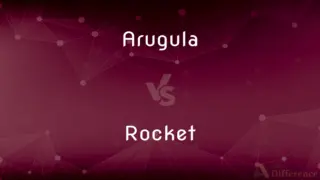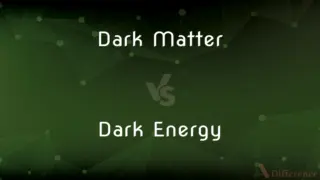Navratri vs. Dussehra — What's the Difference?
By Tayyaba Rehman & Fiza Rafique — Published on February 4, 2024
Navratri is a 9-night festival celebrating the goddess Durga; Dussehra follows Navratri, marking Lord Rama's victory over Ravana.

Difference Between Navratri and Dussehra
Table of Contents
ADVERTISEMENT
Key Differences
Navratri is a significant Hindu festival dedicated to the worship of the goddess Durga, spanning nine nights, each dedicated to a different form of the goddess. It's celebrated with fasting, dancing, and cultural rituals. Navratri symbolizes the triumph of good over evil and involves the invocation of divine feminine power.
Dussehra, also known as Vijayadashami, occurs on the tenth day after Navratri, commemorating the victory of Lord Rama over the demon king Ravana, as depicted in the epic Ramayana. This day symbolizes the victory of righteousness and the triumph of good over evil, celebrated by burning effigies of Ravana and enacting scenes from the Ramayana.
While Navratri is a festival of devotion, inner reflection, and prayer, focusing on the aspects of the divine feminine, Dussehra is more about the public celebration of the victory of good over evil. Both festivals are deeply rooted in Hindu mythology but highlight different aspects of the human experience and spiritual principles.
Navratri's celebration involves various regional traditions, including Garba and Dandiya dances, especially prominent in Gujarat and Maharashtra. The festival is marked by vibrant attire, fasting, and elaborate rituals. Dussehra, on the other hand, is celebrated with processions, theatrical enactments of the Ramayana, and the burning of Ravana's effigies, especially significant in North India.
In essence, Navratri and Dussehra together encapsulate the essence of divine struggle and victory, with Navratri focusing on the reverence of divine feminine energy and Dussehra celebrating the triumph of divine masculine energy. Both festivals, while distinct in their observance and symbolism, collectively emphasize the perpetual theme of good prevailing over evil.
ADVERTISEMENT
Comparison Chart
Duration
9 nights
1 day (follows Navratri)
Main Deity
Goddess Durga
Lord Rama
Significance
Celebrates the divine feminine and Durga's victory over Mahishasura
Marks Rama's victory over Ravana, symbolizing good over evil
Celebrations
Fasting, prayers, dance (Garba and Dandiya)
Burning of Ravana effigies, plays, and processions
Symbolism
Inner reflection, devotion, and the power of Shakti
Victory of righteousness, and the importance of dharma
Compare with Definitions
Navratri
Navratri is a time for spiritual reflection and prayer.
Many observe fasting throughout the devotional period of Navratri.
Dussehra
Celebrated on the tenth day after Navratri, marking divine victory.
Dussehra is a reminder of the power of righteousness and moral values.
Navratri
Each night of Navratri is dedicated to a form of Goddess Durga.
Navratri's nine nights are a journey through the many aspects of the goddess.
Dussehra
Theatrical enactments of the Ramayana are central to Dussehra.
Local actors bring the story of Rama to life every Dussehra.
Navratri
A Hindu festival spanning nine nights dedicated to the goddess Durga.
During Navratri, the city is alive with vibrant dances and colorful attire.
Dussehra
Dussehra emphasizes the importance of dharma (righteous living).
Dussehra inspires us to follow the path of virtue in our lives.
Navratri
Fasting during Navratri is a common practice for purification.
She observes a strict diet during Navratri as a form of spiritual cleansing.
Dussehra
Dussehra symbolizes the triumph of good over evil.
The city's Dussehra parade vividly portrays the epic battle of Rama and Ravana.
Navratri
Navratri is known for its traditional dances, Garba and Dandiya.
Navratri brings people together for nightly Garba dances.
Dussehra
A Hindu festival marking the victory of Lord Rama over Ravana.
Dussehra ends with the dramatic burning of Ravana's effigies.
Common Curiosities
What is Navratri?
Navratri is a Hindu festival that lasts for nine nights, dedicated to worshipping Goddess Durga.
How is Dussehra celebrated?
Dussehra is celebrated by burning effigies of Ravana, enacting scenes from the Ramayana, and processions.
What are the key traditions of Navratri?
Navratri traditions include fasting, prayer, dance (like Garba and Dandiya), and worshipping different forms of Goddess Durga.
How are Navratri and Dussehra related?
Dussehra follows the nine nights of Navratri and is considered the culmination of the festivities.
Can Navratri and Dussehra be celebrated by non-Hindus?
Yes, people from different backgrounds often participate in the cultural aspects of Navratri and Dussehra celebrations.
What is the importance of music and dance in Navratri?
Music and dance, especially Garba and Dandiya, are integral to Navratri, celebrating the joyous spirit of the festival.
Are there any environmental concerns associated with Dussehra celebrations?
Yes, the burning of Ravana effigies and the use of fireworks have raised environmental concerns.
Is there a specific color associated with each day of Navratri?
Yes, each day of Navratri is associated with a specific color, which many devotees wear to honor the goddess.
How do different regions in India celebrate Dussehra?
Dussehra celebrations vary widely across India, with some regions focusing on Ramlila, while others may have unique local traditions.
What does Dussehra signify?
Dussehra marks the victory of Lord Rama over the demon king Ravana, symbolizing good prevailing over evil.
What is the significance of Ramlila during Dussehra?
Ramlila is a theatrical enactment of Lord Rama's life story, culminating in his victory over Ravana, highlighted during Dussehra.
What foods are typically consumed during Navratri?
During Navratri, many consume vegetarian meals, fruits, and special fasting foods like sabudana and singhara.
Can Navratri and Dussehra celebrations vary within the same country?
Yes, regional variations in rituals, traditions, and celebrations are common due to India's cultural diversity.
Why do some people fast during Navratri?
Fasting during Navratri is a form of purification and devotion to Goddess Durga.
What lessons can be learned from Navratri and Dussehra?
These festivals teach the importance of devotion, righteousness, and the power of good over evil.
Share Your Discovery

Previous Comparison
ScvO2 vs. SvO2
Next Comparison
Confidence vs. OverconfidenceAuthor Spotlight
Written by
Tayyaba RehmanTayyaba Rehman is a distinguished writer, currently serving as a primary contributor to askdifference.com. As a researcher in semantics and etymology, Tayyaba's passion for the complexity of languages and their distinctions has found a perfect home on the platform. Tayyaba delves into the intricacies of language, distinguishing between commonly confused words and phrases, thereby providing clarity for readers worldwide.
Co-written by
Fiza RafiqueFiza Rafique is a skilled content writer at AskDifference.com, where she meticulously refines and enhances written pieces. Drawing from her vast editorial expertise, Fiza ensures clarity, accuracy, and precision in every article. Passionate about language, she continually seeks to elevate the quality of content for readers worldwide.















































